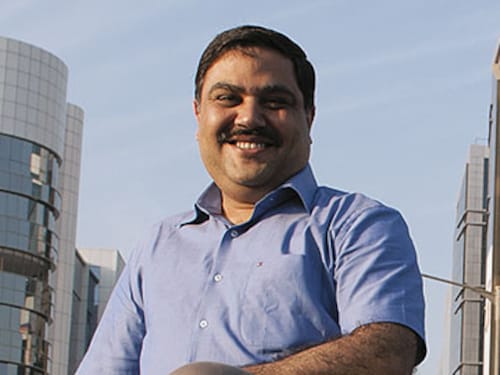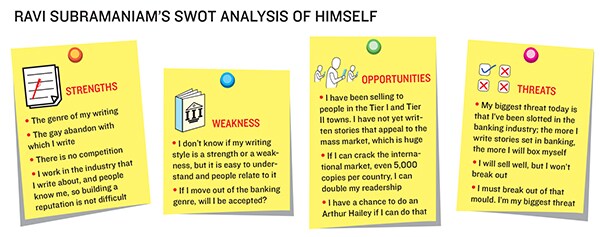Ravi Subramanian's Bank Account Contains Thrillers
Ravi Subramanian's day job provides not just material, but also marketing skills for his books


Ravi Subramanian
Age: 42
Profession: Banker, writer
Genre: He has written five books that deal with the banking industry. His first book If God Was a Banker was a huge hit in the banking industry and readers felt it described the culture of Citibank in early 2000. His fourth novel The Incredible Banker won the Economist-Crossword Book Award in 2011.
Ravi Subramanian’s fifth book, The Bankster, launched a few months ago at a Bombay bookstore to a packed audience: Friends and former colleagues from HSBC, yes, but also a sizeable contingent of fans, and even financial journalists. Subramanian told the assembled throng how he had released characters from his book in the form of comic strips and had given away almost 40 percent of the story on Facebook. He had done so with a clear plan. He wanted to create a buzz about the book on social media so that when the book was launched, there would be enough people who would go and buy it. He had hired a team of professionals to do the graphics and a slide show for the launch.
And it all paid off. He was able to put The Bankster on the bestsellers list from its very first week in the wild. It hadn’t always been that easy, though.
Subramanian, despite his clearly South Indian name, is practically a naturalised Punjabi: He grew up in Ludhiana, where his father taught in an engineering college. After his parents moved back to Karnataka, Subramanian stayed on to finish college.
He had grown up reading the usual round of imported bestsellers that Indian kids in the seventies and eighties had access to: Jeffery Archer, John Grisham, Arthur Hailey, James Hadley Chase and so on. He also started reading paperback thrillers in Hindi, by Surendra Mohan Pathak and the like, which he bought at railway stations and devoured on the overnight train journeys he took to visit his parents. These moulded his reading tastes and also his writing ambitions.
For, though he went on to IIM Bangalore, and has since had a very successful career in banking, he knew he always wanted to be a writer. That, he decided, was the only route to a kind of immortality.
As he says, “Ask someone who the CEO of a certain organisation was five years ago, nobody will remember. But if you ask who wrote a particular book—if the book is successful—they will remember. Somewhere I always wanted to be remembered by my books after I’m gone.”
And so, in the mid-noughties, settled in his career and personal life, he began to write. He chose to set his story in the world he knew best: Banking. Two drafts later, he did the rounds of the publishers, and collected a respectable sheaf of rejection letters.
Then he did the thing all successful executives know well: He networked. He got in touch with Kapish Mehra and chatted with him, CEO-to-CEO. Mehra, scion of home grown publishing major, Rupa Publications, had made his bones publishing Five Point Someone, the Chetan Bhagat bestseller.
His methods were straightforward: Look for a pool of readers large enough to be a good market, then find content that they would relate to. He had spotted the emergence of a new generation of young Indians, brought up on popular Indian cinema and television and at ease with their Indianness, comfortable enough in English, but not particularly at ease with either the subjects or the literary writing that the top Indian writers were putting out.
When Bhagat’s book came his way, he gambled on this generation loving a book that told the stories of their particular lives. And Bhagat and he have been chortling their way to the bank ever since. Mehra was now on the lookout for his next big thing.
When he went through Subramanian’s work, he connected the dots to a trend he had noticed: People migrating from smaller towns to big cities to work in banks, lured by the sector’s fast growth and attractive salaries. There were enough of them, and with money to spend, to form an attractive target audience.
“Besides,” he says, “Ravi has this talent of building a story that takes the reader into the book from page one. He understands banking and he wrote about its problems before the global crisis. I knew this book would do well because there was a hungry reader waiting for such a book.”
Even so, Rupa’s first print run of If God was a Banker was a conservative 2,000. For its launch in June 2007, there were going to be just 120 copies on sale. Subramanian persuaded bookstores (with some difficulty) to ratchet up its order, and he was vindicated: About 220 copies were sold on the very first day.
The book was hardly marketed, he says, and besides, he himself wasn’t very confident about his own creation. But it continued to do well, even earning some notoriety: Citibank was rumoured to have banned the book, because the hard-driving, ruthless, even vicious bank its [book’s] protagonists worked in, was allegedly modelled on it.
Despite—or maybe because of—the gossip, the book did well, and even became something of a cult in banking circles, selling around 2.65 lakh copies, enough for Subramanian to buy himself a BMW with the royalties. More importantly for his ambitions, it gave him the opportunity to write more.
His next two books (I Bought the Monk’s Ferrari, 2008 and Devil in Pinstripes, 2010) were successful but not blockbusters. About then, Subramanian came to the conclusion that books were like any other product, and needed to be marketed. He decided to put into practice all that he had learnt in B-school and his retail banking career. He started thinking like a manager.
In 2011, when his fourth book, The Incredible Banker, was about to launch, he pulled out all the stops. He put in long hours promoting it on social media, and was well-rewarded: It sold over 1.2 lakh copies in one year. As he says, “It is how much hype and buzz you create about the book prior to the launch which really helps you succeed. If you do well in the first month, then word-of-mouth spreads and people start picking up the book.”
With The Bankster, he ramped it up some more, hiring professionals to help him market the book. He is a familiar face at all the bookstores, where he monitors his sales regularly, making sure his books are visible, pushing the store managers to keep inventory solid.
A bad book won’t sell, he says, no matter how much the effort. “But a lot of good products fail because nobody puts their weight behind them and pushed them.”
He is disarmingly frank about the quality of his writing—and he doesn’t resent criticism on that score—but he believes that he has the ability to tell a good, relatable story. Rather like his role models, Grisham and Hailey. And he admires Hailey more, because of the varied worlds his books inhabited, from airports to pharmaceuticals to hotels, and the huge amount of research that went into each of them.
He wonders if he, like Hailey, should write about new areas each time, rather than stay in his comfort zone, banking. And he’s making that attempt: The book he is currently working on, is set partly in academia. Of course, he plans to use his own world as material too. He’s looking at the recent Reebok scandal seriously, and figuring out if he can incorporate elements of that story into a future book.
Rahul Dravid is one of his other icons. He admires the cricketer for his patience, persistence and style, but more importantly, for his visible integrity and honesty, qualities Subramanian holds above everything else. “Nobody is as honest as Dravid in Indian cricket.” He’s hoping to get Dravid to launch The Bankster in Bangalore.
Subramanian is more than a little enamoured with cricket. Maneesh Srivastava, who worked with him at HSBC and is now CEO of Muthoot Housing Finance, says “Every time we ended a meeting it would eventually turn into a game of cricket on his floor!”
Subramanian also admires Jeffery Archer’s attitude towards his readers. He was with Archer at an event once, and remembers him signing 500 copies at a stretch for his fans, and his signature did not waver from first to last.
When he commented, awed, Archer smiled and said, “If your best fan is the 500th person, then you will be doing him injustice [if you sign sloppily].” Subramanian says this is a very Dravid-attitude, and, incidentally, “Archer is a huge Dravid fan”. When we bring up Archer’s prison sentence, Subramanian smiles and indicates that his admiration is only for the professional side of Archer.
In Dravid mould, Subramanian puts in the hours. He spends two to three hours writing every night, after his wife and daughter are asleep, and on weekends, he puts in four or five hours a day. When he’s in the flow, he puts down a novel’s first draft—around 80,000 words—in about three months.
Then there’s revision and editing, and that can take as long or even longer (he says he does several start-to-end edits of each draft). All this while holding down a day job, as a senior executive in charge of consumer lending at Shriram Finance.
Why continue with the corporate life? After all, he’s one of India’s best-selling authors. As his new books came out, they in turn, helped the sales of his earlier books, and all told, they bring in a very healthy sum. (When we were researching authors for the Forbes India Celebrity 100 list, he disclosed a writing income of Rs 67 lakh in the period between October 2011 to September 2012.)
Subramanian is reasonably sure that he won’t turn full-time writer in the foreseeable future. “I don’t depend on writing for money or for living,” he says. “So, I don’t have to think twice to spend money to promote my book. The moment I start depending on writing for my living, it will start pinching. I enjoy my writing because it is not a job for me. If I start depending on it, I’m not sure I will have the same fascination for it. Then I will have to write even if I don’t want to, because I will have deadlines to meet, and then it will become boring.”
Besides, “My work, my contacts and my relationships and the people that I know and move around with, in some way, are fodder for my writing.
I write popular thrillers about life in the corporate world if I’m out of work, I will be out of touch with reality”.
When we give examples of other writers who have made the switch, he grins. “Nobody gives up good jobs in India for writing. They had to give up their careers for other reasons, and then made it into a virtue.”
That was the only hint of snark in a long conversation that was generous in praise for everyone but himself. So, no, he won’t quit: “I will continue writing and working as long as possible.”
Right now, he is quite pleased with The Bankster, which he says is his best book. “Most people have not been able to figure out the end even with just 20 pages left.” And that, more than the money could ever be, is his motivation and vindication.
“I don’t consider myself to be a great writer but I’m a reasonably good storyteller and if you read The Bankster, you will know what I’m talking about. I challenge you to put the book down after page 100.”
First Published: Feb 19, 2013, 06:11
Subscribe Now